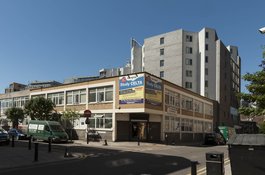101 Greenfield Road (incorporating 18–24 Fieldgate Street)
Contributed by Survey of London on July 2, 2018
One of the earliest synagogues on Fieldgate Street was the Crawcour Shul, a
'landsmanschaft' of immigrants from Kraków, Galicia, then Austria (now Poland)
that was formed in 1887. Their premises in an annexe at the back of a
shophouse at what became No. 18 were bought by the Litvish Chevra Bnai Wilna
in 1890, and immigrants from Vilnius, Lithuania, were invited to join. The
synagogue later became the Chechanover Shul (from Ciechanow, Poland) and
survived until the 1950s.
Nathaniel and Ralph Davis (two of the seven Davis brothers) put up tenements
with ground-floor and upper-storey tailoring workshops at 20–24 Fieldgate
Street in 1895–9. By 1961, when it was set to be cleared, 22 Fieldgate
Street had become a lodging house, disapprovingly described by Edith Ramsay as
‘nominally for coloured seamen… housing girls as well as men’.
The County of London Plan of 1943 recommended the dispersal of industry away
from London’s inner boroughs, but recognised that small factories and
workshops, heretofore scattered hither and thither, could not realistically be
banished, but would need in some degree to be kept close to the housing of
those they employed, and gathered together in low-rent premises. A particular
concentration was envisaged around Fieldgate Street, extending from the
Whitechapel Road to Commercial Road between Adler Street and the New Road. In
keeping with this plan, but much more modestly, the Stepney–Poplar
Reconstruction Scheme of the late 1940s proposed an industrial enclave to
either side of Plumber’s Row, a heavily bombed area that took in most of
Greenfield Road up to Fieldgate Street. This clearance and redevelopment
project swung into action in 1954, but compulsory purchase and other
difficulties meant that Walter Bor, the planner–architect in charge of
redevelopment in Stepney in the LCC Architects’ Department’s Town Planning
Division, had to revisit plans for the Plumber’s Row area in 1959 to accept
mixed use.
Building works began in earnest in 1962 with infrastructural preparation that
included the blocking up of Yalford Street. Little was achieved along
Greenfield Road and Plumber’s Row before the 1970s. One of the first buildings
to go up was 101 Greenfield Road, on the west corner of Fieldgate Street. This
was built in 1963–5 to plans by De Groot Collis & Co., surveyors acting as
architects. The first lessees were Lango Ltd, textile wholesalers and jersey-
fabric makers, so the two-storey concrete-framed, brick-clad building became
Lango House. Non-residential institutional use was permitted in 2010 and the
premises are the East London Business Centre in 2018.
Getting my first suit from Goldman's
Contributed by alan on June 19, 2017
I had my first suit made for me at bespoke tailor M. Goldman, 22 Fieldgate
Street. It was quite a performance, measurements, then first and second
fittings. The basters and finishers still sat on the tables to work. That
would have been about 1948 I think. I still have the wooden suit hanger with
its label.
